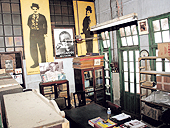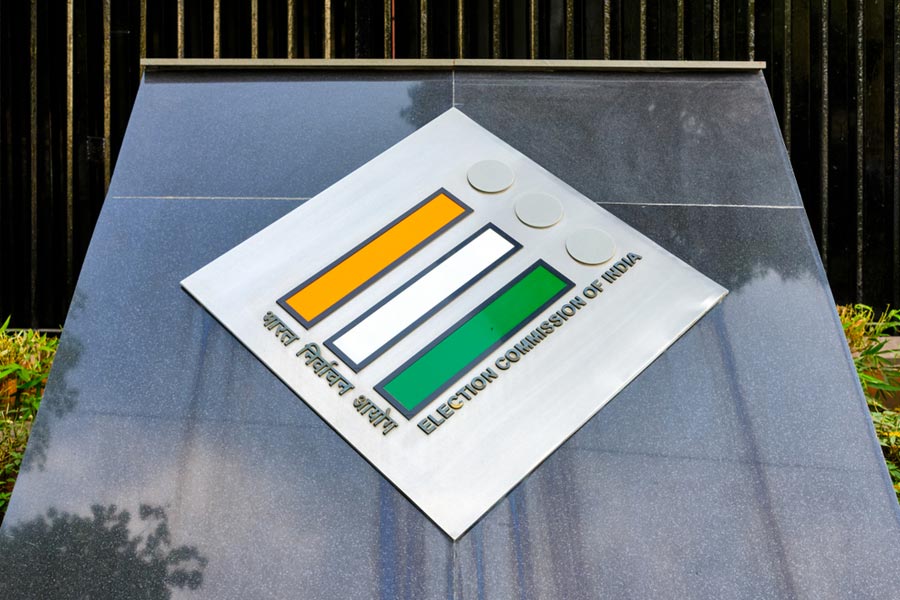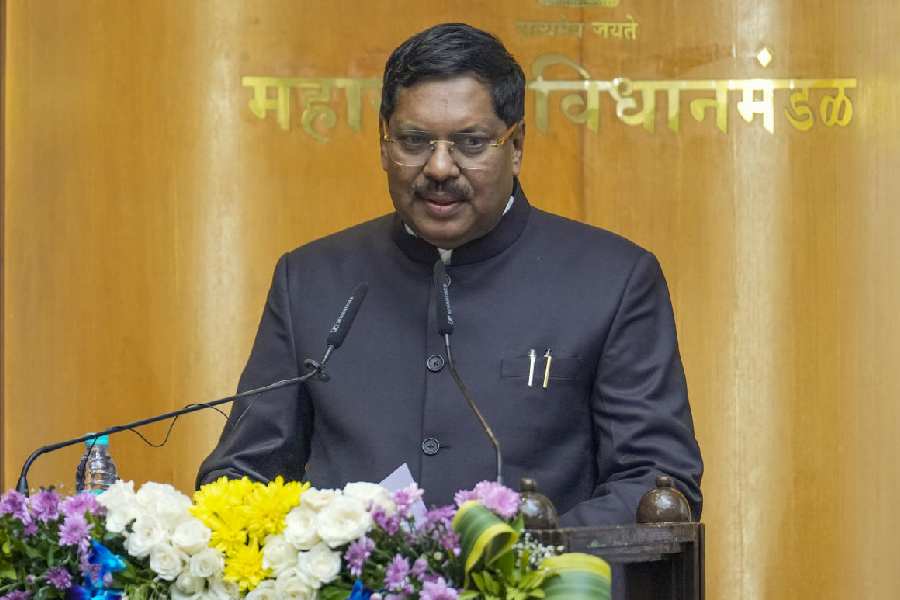 |
 |
| The office of Calcutta Film Society, an institution crumbling much like the feudal system in Jalsaghar (above). Picture on top by Pradip Sanyal |
Technology, globalisation and changing tastes have taken a heavy toll on the film societies, which were once a throbbing part of Calcutta’s cultural life
Rrrring…rrrring…rrrring…. The phone rings and no one picks up. Because there isn’t anyone to pick up. The room, dank and lightless with the paint peeling off, is locked. A fraying board hanging at an angle above the door says in fading letters Calcutta Film Society.
Had Satyajit Ray filmed the sequence it would have been incomparably richer in detail than the poorly imagined picture painted above — everything except the unanswered phone is made up.
He could well have.
The theme might have drawn him. For, like Jalsaghar, the Ray classic where the feudal system is shown collapsing, film societies that had once been a throbbing part of Calcutta’s cultural life are crumbling too.
For three days we called the number 22375613 — afternoon and evening — but no one answered at Calcutta Film Society that Ray had set up in the year of Independence, with friends such as the late RP Gupta and Chidananda Dasgupta, a filmmaker himself and Aparna Sen’s father.
No one answers because, perhaps, no one calls anymore. The club’s Saturday screenings at Bharat Bhavan off Esplanade do not draw more than 30 members.
Critic Samik Bandopadhyay said: “Calcutta Film Society wanted to create a film culture that would allow for a different kind of filmmaking. They saw films as art, as an interpretation of contemporary reality.”
Ray was 26 when the society was born and thirsting for the experience of contemporary world cinema. Those were days when the eyes of the educated young — like those of the young country — were full of the thrill of wanting to taste the adventure that lay in the world beyond.
World films, except Hollywood commercial releases, were beyond reach. Film clubs, where celluloid junkies pooled in their resources, became the vehicle to gain a collective experience.
Film clubs sprouted in Calcutta and districts, coinciding with the golden age of Bengali filmmaking. The city gave birth to about six-seven clubs that grew big. Membership of a club like Cine Central, which is the biggest with 2,500 on its rolls today, became a boast-badge, possibly as hard to acquire as a ticket to a Test match that came to town once in a few years.
“In the sixties and seventies, film clubs were something you had to be a part of. There was no other way you could access world cinema,” said Jyotiprakash Mitra of North Calcutta Film Society, which started in 1968 with a weeklong festival of European masters.
Cine Central’s headcount has dropped 40 per cent. Rabin Banerjee, of 1967-born Cine Academy, said: “The average age of members (about 250) is about 50. And we don’t have any members below 30.”
Ray and his friends had held a screening of the Russian Sergei Eisenstein’s Battleship Potemkin to stamp their club’s class.
Twenty-eight-year-old Mainak Bhaumik, who turned director with what has been described as the first Bengali sex comedy Aamra in 2006, now sees no need to hold a film club membership to watch the Eisenstein classic. He prefers to watch Potemkin or Pather Panchali at home, on a DVD. Bought or hired — from Cinema Paradiso or Raja Electronics, the two city outlets that stock what goes by the name of arthouse, or the “other”, cinema.
Mainak chucked his Cine Central membership. Cinemas, “other” or of any other kind, don’t come in reels sitting in several cans any more.
Like the vinyl record that whirled precariously on a turntable and increasingly like the cassette that wound and unwound its way to end and beginning, the cinema that came in cans has been canned for good. And with it, possibly the future of film clubs in Calcutta.
“Even when they (the big film clubs) conduct a collective show they can’t seem to draw an audience of 100 people,” said film scholar Sanjoy Mukhopadhyay.
The word “collective” holds a special — and now lost — meaning for arthouse film aficionados. From a collective experience during Ray’s time and for, perhaps, almost the next half a century, film watching has changed to an individual or, at best, a small-group activity.
Modern technology, starting from the computer to the email and the Internet, is often condemned as an alienating influence. As the cinema is broken down into digits, the audience for arthouse cinema has also been broken up into digits, mostly single. The fact that one can’t just walk into a multiplex to view this cinema has helped the process of alienation.
What this has done to the film watcher is hard to say but it has sucked the blood out of film clubs.
“Digitalisation and technological advancement is one of the main causes behind the death of film societies but not the only cause. The fact that no one wants to differentiate between popular and art cinema is also a cause,” said Mukhopadhyay.
It’s hard to deny this is a sterile period for Bengali, or even Indian, arthouse movies.
Bandopadhyay traces the phenomenon back to the seventies when he saw evidence of a “mindset divide”. “People started differentiating between commercial and parallel cinema. Bombay’s brand of cinema became more popular. So the ‘other’ cinema suffered.”
Film clubs took a hard knock too from the break-up of the Soviet Union in 1991, which put an end to the smooth, and cheap, flow of films through the USSR consulate.
“State-owned films had to be individually procured from the new countries. That drove up costs and, with dwindling membership, most couldn’t afford it,” said Gautam Ghosh, the co-ordinator of Eisenstein Cine Club, also a Ray child, and programming officer at Gorky Sadan.
The expense — about Rs 30,000 to get a foreign embassy to fly in a film reel — is beyond the means of most clubs. Not surprising then that North Calcutta Film Society hasn’t held a screening in over a year.
The year 1991 was a landmark in one more way. Economic reforms began that year, setting India on course to globalisation, which has only hastened the doom for film clubs. The inaccessible — non-Hollywood cinema — was no longer so. The better book-music-video shops started to stock the greats — Bergman, Kurosawa and Fellini.
Lending libraries like Cinema Paradiso and Raja Electronics followed. Anjan Dutt, director-actor-singer who was a member of two film clubs, carted his allegiance to Raja. “They (the clubs) don’t source prints and new films and screen them. I have had to turn to renting or buying DVDs. Any film I’ve wanted that they don’t have they have sourced it for me,” he said.
Movies entered several university curricula in the late eighties, spawning libraries and archives stashed with show reels from every corner of the world. Accessibility had ceased to be a problem for the film student, too.
Just as technology and globalisation brought arthouse movies to the individual through these legal methods, pirated copies were their illicit children. Available at times at pavement stores and at certain markets of repute and disrepute, they are a cheap alternative to DVDs from, say, Starmark, the chain store.
For the technology-savvy with time on hand the Internet is another source of illegal downloads that can breed copies.
No longer does one have to wait months and years for the film club to hold a Bergman retrospective and win “have-you-seen-Seventh-Seal” bragging rights.
Cine Academy’s Banerjee understands this. “The only way we can hold screenings now is by teaming up with other societies and splitting the costs.” Cine Academy tags along with Eisenstein Cine Club to screen movies, but only occasionally.
Technology, globalisation, changing tastes — the script is almost written for another Jalsaghar. But, maybe, this is one movie Ray wouldn’t have made; not held his camera on the broken glass pane to peep inside Calcutta Film Society’s locked room, as he had done with Charulata looking out into the world from her window.
It would have been too close to his heart.
Where to go for the ‘other’ cinema
![]() Seagull Arts and Media Resource Centre: Has seven viewing consoles and 4,000 films from across the world. A maximum of two people can sit at a console at a time. Membership fee: Rs 1,200 (annual), Rs 600 (half-yearly), Rs 300 (monthly) and Rs 50 (daily).
Seagull Arts and Media Resource Centre: Has seven viewing consoles and 4,000 films from across the world. A maximum of two people can sit at a console at a time. Membership fee: Rs 1,200 (annual), Rs 600 (half-yearly), Rs 300 (monthly) and Rs 50 (daily).
![]() Max Mueller Bhavan: Its archive has more than 300 films. Max Mueller Bhavan screens films at regular intervals. You have to be listed in the database to get an update on the screening schedule. Membership not required.
Max Mueller Bhavan: Its archive has more than 300 films. Max Mueller Bhavan screens films at regular intervals. You have to be listed in the database to get an update on the screening schedule. Membership not required.
![]() The French Association (Alliance Francaise): French movies are screened every Tuesday, 6pm. Screenings are open to all but there are only 30 seats. You can also borrow films; the annual membership fee is Rs 500.
The French Association (Alliance Francaise): French movies are screened every Tuesday, 6pm. Screenings are open to all but there are only 30 seats. You can also borrow films; the annual membership fee is Rs 500.
![]() Cinema Paradiso: The DVD rental chain has two outlets — one in Rowland Row and the other in BE Block, Salt Lake. Lifetime membership is Rs 3,000. You can borrow a DVD for Rs 100 and keep it for three nights. The two branches have 1,000 members.
Cinema Paradiso: The DVD rental chain has two outlets — one in Rowland Row and the other in BE Block, Salt Lake. Lifetime membership is Rs 3,000. You can borrow a DVD for Rs 100 and keep it for three nights. The two branches have 1,000 members.
![]() Raja Electronics: The DVD rental shop on AJC Bose Road charges a lifetime membership fee of Rs 4,000. Rental charge for world cinema is Rs 104 per DVD.
Raja Electronics: The DVD rental shop on AJC Bose Road charges a lifetime membership fee of Rs 4,000. Rental charge for world cinema is Rs 104 per DVD.
Have you watched wong?
Today’s world-movie buffs are watching the legends Ingmar Bergman and Akira Kurosawa as much as they do Wong Kar-wai.
The Hong Kong-based Wong, 50, won the Best Director prize for Happy Together at Cannes in 1997. His first full-length English feature film is My Blueberry Nights, made last year, in which the singer Norah Jones, Ravi Shankar’s daughter, made her acting debut.
“Wong is very big now, something like Shah Rukh Khan,” says Nikhil Arolkar, a first-year student of cinematography at the Satyajit Ray Film & Television Institute. He also likes Thai director Apichatpong Weerasethakul’s Tropical Malady and Mysterious Object at Noon, and Argentine filmmaker Lucrecia Martel’s The Swamp.
“In the world cinema section at Cinema Paradiso, the most in demand is Kurosawa,” says the owner Santosh Gopal. Kurosawa’s Seven Samurai and Rashomon are 23-year-old car company exec Shayan Sarkar’s favourites. He also loves Stanley Kubrick and Vittorio de Sica.
Sudeb Sinha of Drishya, which calls itself a “film organisation” with 40 members but not a club and holds screenings occasionally, says there’s a “huge demand” for Bergman. “Most people ask for The Seventh Seal, but Wild Strawberries, Summer Interlude, Summer with Monica and Autumn Sonata too have several takers.”
Among contemporaries, the works of Iranian directors Mohsen Makhmalbaf (Kandahar), Abbas Kiarostami (The Wind Will Carry Us) and Jafar Panahi (The Circle) are much sought after. Raka Dutta, a former student of the Ray institute, says her Top Five are Bergman, Kiarostami, Taiwanese director Tsai Ming-liang (The Wayward Cloud), Hungarian Bela Tarr (Satan’s Tango) and Wong.
For Anusha Kumar, a first-year student of direction at the same institute, it’s Wong and Weerasethakul.
“A greater number of students come looking for Bergman, Kurosawa and (Michelangelo) Antonioni as they have to study European classics,” says Arijit Bhattacharya, the library-in-charge at Seagull Arts and Media Resource Centre.
Mainak Bhaumik, a young filmmaker, picks Woody Allen, Pulp Fiction and Kill Bill man Quentin Tarantino, Canadian director Atom Egoyan (The Sweet Hereafter) and American writer-director-producer Judd Apatow (Forgetting Sarah Marshall) as his inspiration.










